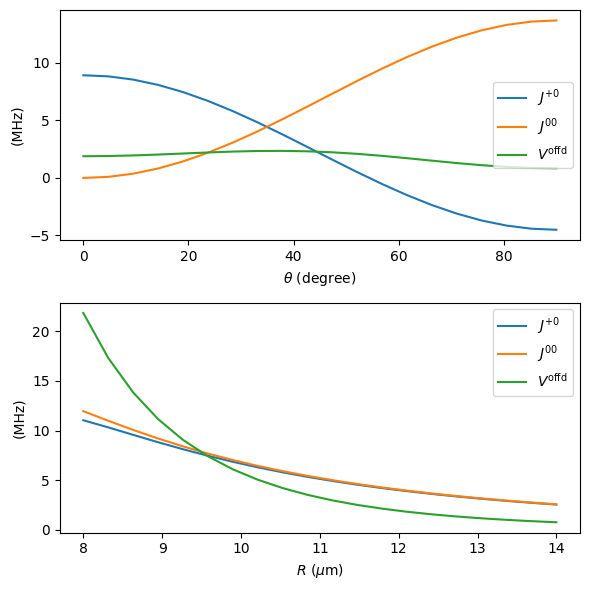This page was generated from the Jupyter notebook
perturbative_h_eff.ipynb.
Open in
Google Colab.
Effective Hamiltonian
This notebook demonstrates how to calculate an effective Hamiltonian with the pairinteraction.perturbative module. We use https://arxiv.org/pdf/2410.21424 as a reference and try to reproduce figure 2c) and d) from the paper. Note that the paper used a Schrieffer-Wolff transformation to calculate the effective Hamiltonian, while here we use perturbation theory up to third order.
[2]:
%pip install -q matplotlib numpy pairinteraction
import logging
import matplotlib.pyplot as plt
import numpy as np
import pairinteraction.real as pi
from pairinteraction import perturbative
logging.basicConfig(level=logging.ERROR)
[3]:
if pi.Database.get_global_database() is None:
pi.Database.initialize_global_database(download_missing=True)
[4]:
kets = {
"+": pi.KetAtom("Rb", n=81, l=0, j=0.5, m=0.5),
"0": pi.KetAtom("Rb", n=80, l=1, j=1.5, m=1.5),
"-": pi.KetAtom("Rb", n=80, l=0, j=0.5, m=0.5),
}
pair_energy = kets["0"].get_energy("GHz") * 2
basis = pi.BasisAtom(
species="Rb",
n=(78, 83),
l=(0, 2),
j=(0.5, 4.5),
)
system = pi.SystemAtom(basis=basis)
system.set_diamagnetism_enabled(True)
system.set_magnetic_field([0, 0, 60.7], "gauss")
system.diagonalize()
delta_energy = 5 # GHZ
basis_pair = pi.BasisPair(
[system, system],
energy=(pair_energy - delta_energy, pair_energy + delta_energy),
energy_unit="GHz",
)
system_pair = pi.SystemPair(basis_pair)
system_pair.set_interaction_order(3)
[4]:
SystemPairReal(BasisPairReal(|Rb:78,S_1/2,-1/2; Rb:83,S_1/2,-1/2⟩ ... |Rb:83,P_3/2,3/2; Rb:78,S_1/2,1/2⟩), is_diagonal=True)
[5]:
theta_list = np.linspace(0, 90, 20) # degree
R_list = np.linspace(8, 14, 20) # mum
theta_default = 35.1 # rad
R_default = 11.6 # mum
order = 3
[6]:
kets_list = [(kets["+"], kets["-"]), (kets["0"], kets["0"]), (kets["-"], kets["+"])]
H_eff = {"theta": [], "R": []}
for theta in theta_list:
system_pair.set_distance_vector(
R_default * np.array([np.sin(theta * np.pi / 180), 0, np.cos(theta * np.pi / 180)]),
"micrometer",
)
h_eff, _ = perturbative.get_effective_hamiltonian_from_system(
kets_list, system_pair, order, unit="MHz"
)
H_eff["theta"].append(h_eff)
for R in R_list:
system_pair.set_distance_vector(
R
* np.array(
[np.sin(theta_default * np.pi / 180), 0, np.cos(theta_default * np.pi / 180)]
),
"micrometer",
)
h_eff, _ = perturbative.get_effective_hamiltonian_from_system(
kets_list, system_pair, order, unit="MHz"
)
H_eff["R"].append(h_eff)
[7]:
pair_energy = kets["+"].get_energy("GHz") + kets["0"].get_energy("GHz")
basis_pair = pi.BasisPair(
[system, system],
energy=(pair_energy - delta_energy, pair_energy + delta_energy),
energy_unit="GHz",
)
system_pair = pi.SystemPair(basis_pair)
system_pair.set_interaction_order(3)
kets_list = [(kets["+"], kets["0"]), (kets["0"], kets["+"])]
H_eff_p0 = {"theta": [], "R": []}
for theta in theta_list:
system_pair.set_distance_vector(
R_default * np.array([np.sin(theta * np.pi / 180), 0, np.cos(theta * np.pi / 180)]),
"micrometer",
)
h_eff, _ = perturbative.get_effective_hamiltonian_from_system(
kets_list, system_pair, order, unit="MHz"
)
H_eff_p0["theta"].append(h_eff)
for R in R_list:
system_pair.set_distance_vector(
R
* np.array(
[np.sin(theta_default * np.pi / 180), 0, np.cos(theta_default * np.pi / 180)]
),
"micrometer",
)
h_eff, _ = perturbative.get_effective_hamiltonian_from_system(
kets_list, system_pair, order, unit="MHz"
)
H_eff_p0["R"].append(h_eff)
[10]:
H_eff = {key: np.array(value) for key, value in H_eff.items()}
H_eff_p0 = {key: np.array(value) for key, value in H_eff_p0.items()}
fig, axs = plt.subplots(2, 1, figsize=(6, 6))
axs[0].plot(theta_list, H_eff_p0["theta"][:, 0, 1], "C0-", label=r"$J^{+0}$")
axs[0].plot(theta_list, H_eff["theta"][:, 0, 1], "C1-", label=r"$J^{00}$")
axs[0].plot(theta_list, H_eff["theta"][:, 0, 2], "C2-", label=r"$V^\text{offd}$")
axs[0].set_xlabel(r"$\theta$ (degree)")
axs[1].plot(R_list, H_eff_p0["R"][:, 0, 1], "C0-", label=r"$J^{+0}$")
axs[1].plot(R_list, H_eff["R"][:, 0, 1], "C1-", label=r"$J^{00}$")
axs[1].plot(R_list, H_eff["R"][:, 0, 2], "C2-", label=r"$V^\text{offd}$")
axs[1].set_xlabel(r"$R$ ($\mu$m)")
for ax in axs:
ax.legend()
ax.set_ylabel(r"(MHz)")
fig.tight_layout()
plt.show()
